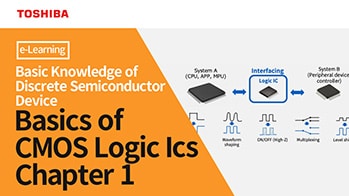-
My ToshibaSemicon
- 반도체 탑
-
애플리케이션Automotive
Body Electronics
xEV
In-Vehicle Infotainment
Advanced Driver-Assistance Systems (ADAS)
Chassis
IndustrialInfrastructure
BEMS/HEMS
Factory Automation
Commercial Equipment
Consumer/PersonalIoT Equipment
Healthcare
Wearable Device
Mobile
Computer Peripherals
-
제품자동차 디바이스
Discrete Semiconductor
다이오드
트랜지스터
로직 IC
Analog Devices
Digital Devices
Wireless Devices
※
: Products list (parametric search)
파워반도체※
: Products list (parametric search)
Isolators/Solid State RelaysPhotocouplers
Digital Isolators
Solid State Relays
Fiber Optic Transmitting Modules
※
: Products list (parametric search)
MOSFETsIGBTs/IEGTs바이폴라 트랜지스터※
: Products list (parametric search)
다이오드※
: Products list (parametric search)
마이크로컨트롤러모터 드라이버 ICIntelligent Power ICs※
: Products list (parametric search)
전원관리IC리니어 IC※
: Products list (parametric search)
범용로직IC리니어 이미지 센서기타 제품용 IC기타 제품용 IC
※
: Products list (parametric search)
-
개발/설계 지원
-
기술 자료
- 구매처
- 부품 번호 & 키워드 검색
- 상호 참조 검색
- 파라미터 검색
- 재고 확인 및 구매
This webpage doesn't work with Internet Explorer. Please use the latest version of Google Chrome, Microsoft Edge, Mozilla Firefox or Safari.
3글자 이상 입력하세요. Search for multiple part numbers fromhere.
The information presented in this cross reference is based on TOSHIBA's selection criteria and should be treated as a suggestion only. Please carefully review the latest versions of all relevant information on the TOSHIBA products, including without limitation data sheets and validate all operating parameters of the TOSHIBA products to ensure that the suggested TOSHIBA products are truly compatible with your design and application.Please note that this cross reference is based on TOSHIBA's estimate of compatibility with other manufacturers' products, based on other manufacturers' published data, at the time the data was collected.TOSHIBA is not responsible for any incorrect or incomplete information. Information is subject to change at any time without notice.
3글자 이상 입력하세요.
What is fanout of a general-purpose logic IC?
Fanout is the number of general-purpose logic inputs that can be driven by one general-purpose logic output.
Therefore, fanout is equal to the output current of the driving IC divided by the input current of the driven ICs:
Fanout = IOH / IIH or IOL / IIL
This calculation used to have a significant meaning for TTL logic ICs that were commonly used before the advent of CMOS logic ICs. However, since the DC input current of the current CMOS logic ICs is on the order of microamperes, input current does not impose a major constraint on fanout.
In the case of CMOS logic ICs, the capacitance of the driven ICs acts as a limiting factor. Generally, it is not recommended to intentionally connect large capacitance to the output of a CMOS logic IC. Typically, the input capacitance of a CMOS logic IC is on the order of 10 pF. (It depends on the product family. See the datasheet.) The sum of the capacitances that can be connected to an output of a CMOS logic IC is specified to be up to 500 pF.
Refer to the following FAQ:
Are there any regulations for the capacitance of the capacitor attached to the output terminal of a general-purpose logic IC?
Therefore, up to 50 CMOS logic ICs can be connected to an output of a CMOS logic IC. However, care should be exercised as to the following:
The rising slope of the signal waveform becomes shallow, increasing the propagation delay time.
(The propagation delay times shown in the datasheet are measured with an output capacitance of 50 pF.)
An increase in load capacitance (i.e., the sum of the input capacitances of the driven ICs) causes an increase in current consumption due to charging and discharging.
Refer to the following FAQ:
How can the power dissipation of a general-purpose logic IC be calculated?
Therefore, perform a board evaluation in advance to ensure that CMOS logic ICs work properly.
Related Links
The following documents also contain related information.




